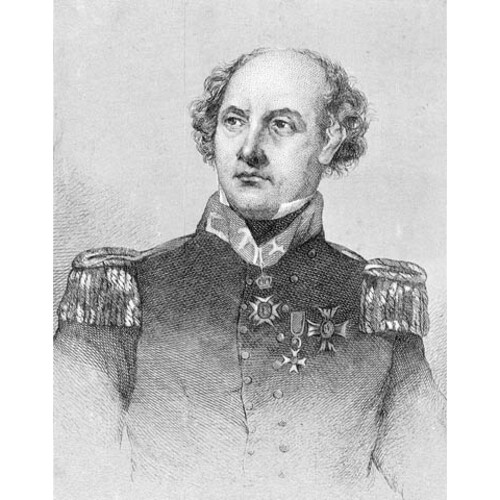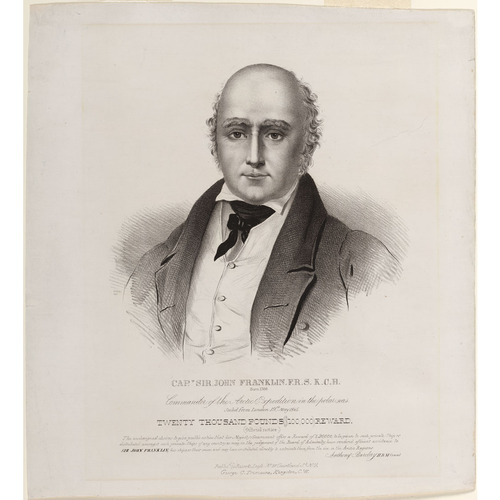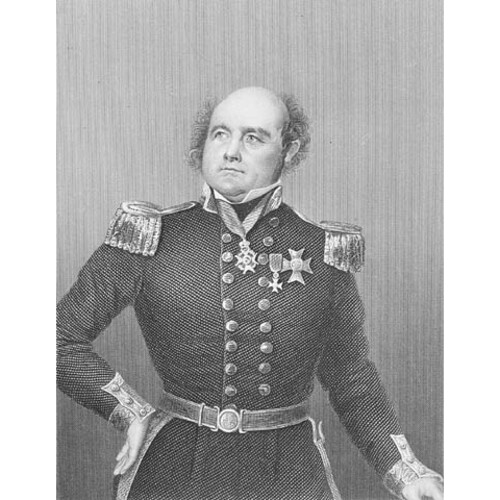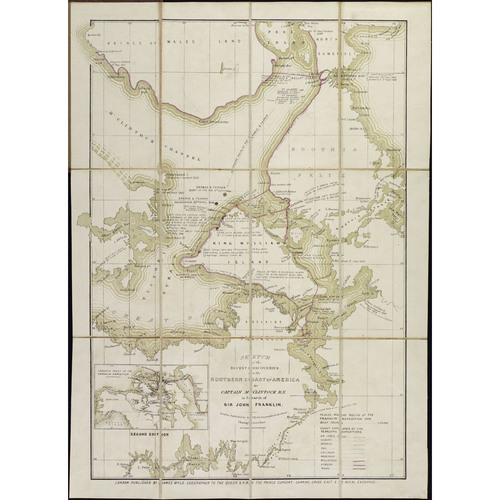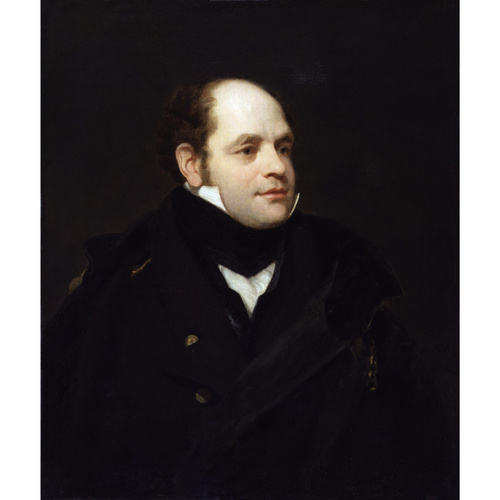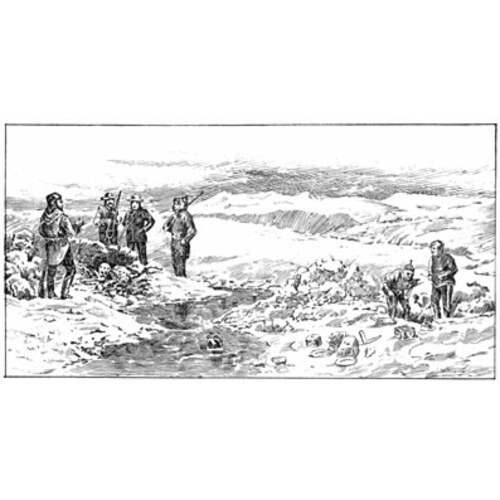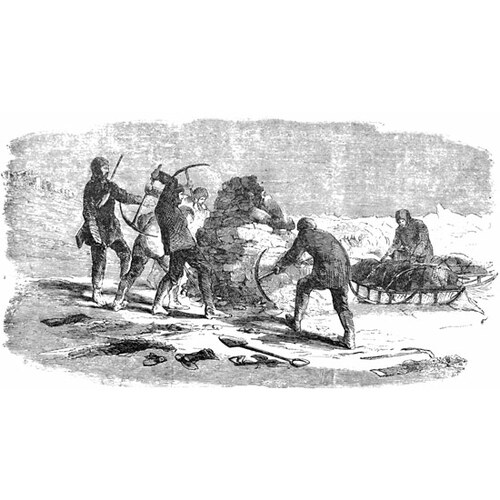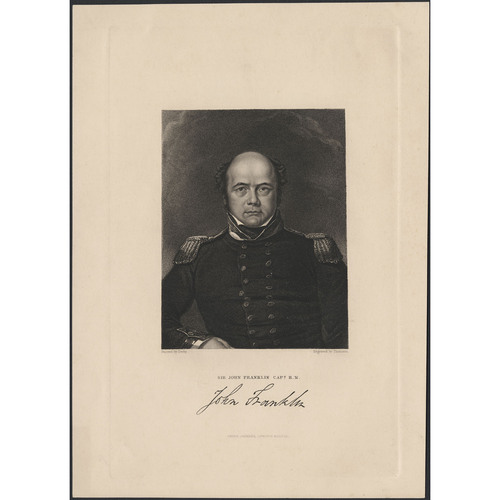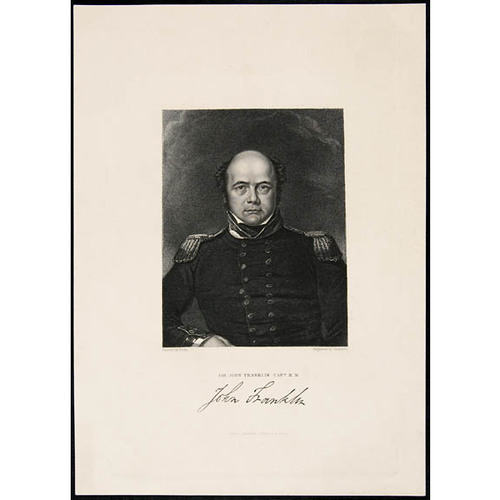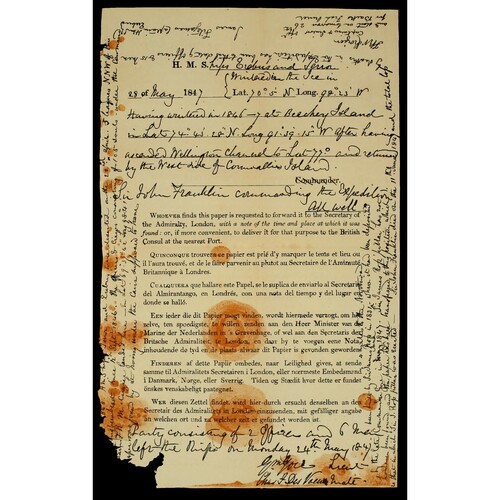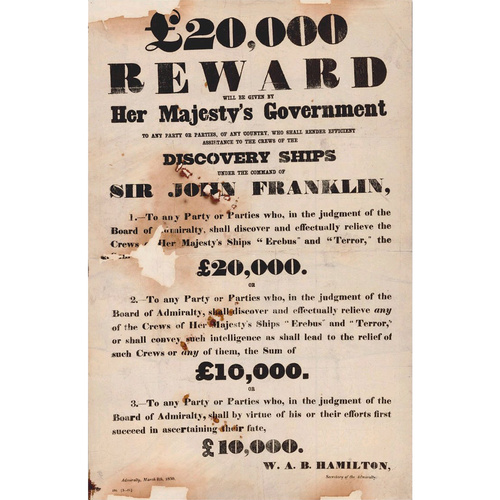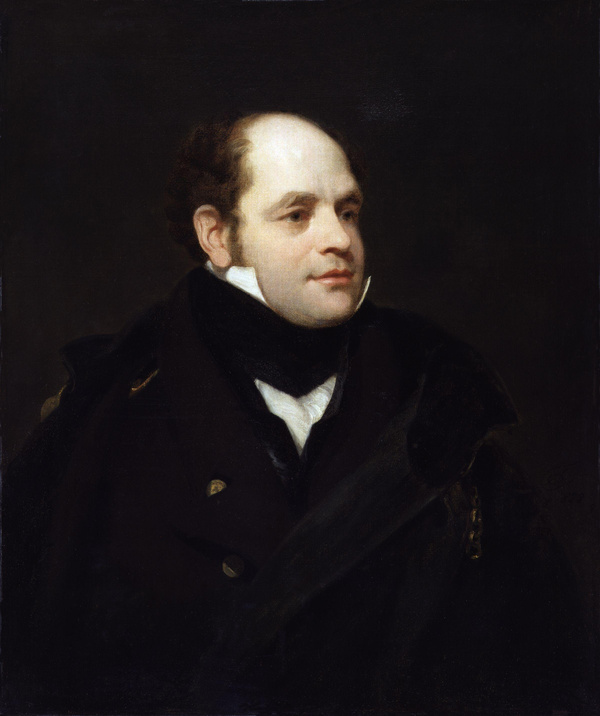
Source: Courtesy of Wikimedia Commons
FRANKLIN, Sir JOHN, naval officer, Arctic explorer, and author; b. 16 April 1786 in Spilsby, England, youngest son of Willingham Franklin, mercer, and Hannah Weekes; d. 11 June 1847 off King William Island (N.W.T.).
John Franklin was educated at preparatory school in St Ives, Huntingdonshire, and, from the age of 12, at Louth grammar school near Spilsby in Lincolnshire. He was attracted to a seafaring life from an early age but met initial resistance from his father, who reluctantly permitted him a trial voyage on a merchant ship sailing between Kingston upon Hull and Lisbon. The trip confirmed his resolve to go to sea, so his father secured his appointment in the Royal Navy as a first-class volunteer on the Polyphemus. He set off on 23 Oct. 1800 to join the ship, which took part on 2 April 1801 in the battle of Copenhagen.
Soon afterwards Franklin was discharged and returned home, for his parents had secured, at his request, an appointment better suited to his ambitions: a commission to go with the Investigator under Captain Matthew Flinders on an expedition to explore the largely uncharted coast of New Holland (Australia). He joined the ship as midshipman on 27 April and sailed from Spithead on 18 July. Flinders, who was Franklin’s uncle by marriage, took the boy into his care, teaching him navigation. In 1802–3 Flinders circumnavigated Australia but failed to complete his detailed survey because of scurvy among the crew and the ship’s unseaworthiness. The Investigator was abandoned in Sydney and the crew set out for home on the Porpoise in August 1803. That ship, however, was wrecked on a reef six days out of Sydney, and the crew found refuge on a sandbank for six weeks while Flinders sailed for help in a boat. Franklin eventually reached Canton on a merchant ship, and then continued homewards on an East Indiaman, arriving in the summer of 1804.
After his discharge, Franklin returned to war duty on the Bellerophon; it was engaged first in the blockade of Brest, later as an escort for troop-ships sailing for Malta, and in October 1805 in the battle of Trafalgar, during which Franklin acted as midshipman in charge of signals. Franklin remained with the Bellerophon, off the coast of France, until October 1807 when he joined the Bedford for service off South America. He was promoted lieutenant on 11 Feb. 1808. He then saw four years’ blockade duty in the North Sea before the Bedford sailed in September 1814 to take part in the British offensive that winter against New Orleans. During this action Franklin was wounded and was mentioned in dispatches.
When the Bedford returned home in May 1815 the Napoleonic Wars were drawing to an end and, after a brief and inactive service on the Forth, Franklin was discharged on half pay. In common with many other young officers, he found his career threatened by the coming of peace, and he now faced an indefinite period at home without prospect of employment.
The salvation of his career was the revival in 1818 of the Royal Navy’s interest in exploring the Arctic. In that year John Barrow, the Admiralty’s second secretary and a noted traveller, proposed Arctic exploration as an ideal means of employing naval officers and men left idle by the ending of the wars. His particular interest was in finding a navigable sea route between the Atlantic and Pacific oceans, either directly over the North Pole or through the North American Arctic between Baffin Bay and Bering Strait. The latter route, commonly known as the northwest passage, became the focus of British naval exploration for the next 36 years and the name of John Franklin is now inseparably linked with it. His appearance among the few selected to take part was probably due both to his meritorious war record and to his experience of exploration under Flinders. Two Arctic expeditions sailed in 1818: one, under Commander John Ross*, sought the northwest passage; the other, under Commander David Buchan, attempted to cross the Arctic Ocean from Spitsbergen with the barque Dorothea and brig Trent. Franklin was appointed to command the Trent. The latter expedition, taking six months, had no chance of success: the ships spent several weeks in a futile attempt to penetrate the pack-ice northwest of Spitsbergen. Its one positive result was to prove that the polar pack-ice was impenetrable.
Following the unsatisfactory outcome of both expeditions, Barrow proposed that two expeditions should continue the search for a northwest passage in 1819. William Edward Parry* was to seek an entrance to the passage from Baffin Bay; his highly successful expedition eventually determined that Lancaster Sound (N.W.T.) opened a passage towards the west. A second expedition, for which Barrow proposed Franklin as leader, would set out overland from Hudson Bay to explore and chart the north coast of the American continent eastwards from the mouth of the Coppermine River and thereby, in theory, delineate the most direct route for a northwest passage. The plan set many difficulties before Franklin. The coast had been sighted by explorers only twice before – by Samuel Hearne* at the Coppermine in 1771 and by Alexander Mackenzie* at the Mackenzie River’s delta in 1789 – and it lay hundreds of miles north of the territory explored by fur traders. The Hudson’s Bay and North West companies were expected to convey Franklin to the edge of unknown territory and to equip him for the coastal journey, but they were only established as far north as Great Slave Lake (N.W.T.), their supply lines were tenuous, and they were engaged in trade warfare. Franklin had just three months to prepare for an expedition that had few precedents in the history of exploration. Advice was scarce and often misleading or excessively optimistic, and he received assurances of greater assistance from the fur-trading companies than they could actually provide. The party selected to accompany him consisted of midshipmen George Back* and Robert Hood*, surgeon and naturalist John Richardson*, and seaman John Hepburn*.
The party set out from Gravesend on the HBC’s supply ship Prince of Wales on 23 May 1819 and reached York Factory (Man.) on 30 August. The HBC could muster only one boat and one crewman, so Franklin had to leave a large part of his supplies to be forwarded later. The party struggled on with a heavily laden boat along the company’s established route to Cumberland House (Sask.), where they halted for the winter on 23 October. There Franklin found that he still could not obtain sufficient information on the country to the north so, with Back and Hepburn, he set out in mid January on snowshoes for Fort Chipewyan (Alta), an NWC post, leaving Richardson and Hood to bring on the supplies in the spring. At Fort Chipewyan he made arrangements for the recruitment of Indian guides and hunters, but he again met difficulties over shortages of men, and he began to discover that the companies were unable to supply the generous quantities of provisions that had been promised in London. Shortage was to be a prevailing feature of the expedition.
After Richardson and Hood had rejoined Franklin, the expedition, reinforced by some hired voyageurs, left Fort Chipewyan on 18 July 1820. At Fort Providence (Old Fort Providence, N.W.T.), an NWC post on Great Slave Lake’s North Arm, they were met by the trader Willard Ferdinand Wentzel and by Akaitcho, the Copper Indian chief whose men Wentzel had recruited as guides and hunters for the expedition. They continued along the Yellowknife River into unexplored territory, and on 20 August they reached Winter Lake, near which they built Fort Enterprise, their winter quarters.
There, Franklin encountered further problems arising mainly from the acute shortage of essential supplies. Frustrated, he began to respond with tactless and entirely uncharacteristic displays of aggression. His manner served only to diminish his authority over the Indians and voyageurs, and deprived him of much of the goodwill shown earlier by the fur traders. His demands to the companies and the Indians for supplies, accompanied by high-handed threats and accusations, met a cold, resentful response, but Back, on a winter journey to Fort Chipewyan, did manage to recover enough of the supplies left at York Factory to secure the expedition’s immediate future.
They set out down the Coppermine for the coast in July 1821 with critically limited food and ammunition. Franklin’s main hope of success now rested on the cooperation of the Inuit along the coast, but this hope was soon dashed. They sighted an encampment near the river’s mouth, but, despite advance contact by their interpreters, Tattannoeuck* and Hoeootoerock (Junius), their approach was incautious and the Inuit fled in fear. No further opportunity to open relations arose. The coastal voyage eastwards from the Coppermine began on 21 July with the party reduced to 20 men in two Indian canoes. Their progress was slow, and by 18 August they had reached only Turnagain Point on Kent peninsula, where Franklin decided to turn back. Summer was ending, supplies were almost exhausted, and unrest among the voyageurs was turning to rebellion. The canoes were too badly damaged to permit a return by sea, so they set off with one canoe up Hood River. They were soon reduced to travelling mainly on foot. The journey quickly became a terrible ordeal. They frequently had only lichen to eat, and cold and exhaustion further weakened them. Nine men died of starvation or exposure; a man later suspected of cannibalism shot Hood and was executed by Richardson. Further distress awaited the survivors who reached Fort Enterprise, for the Indians had not stocked it with food as expected, and they lived for three more weeks on a broth of discarded deer skins, bones, and lichen. Their ordeal ended on 7 November with the arrival of .Indians located by Back, who took them to Fort Providence.
The expedition spent one more winter in the north and returned to England in the autumn of 1822. It had been a failure in most respects, with much suffering and loss of life in return for limited geographical attainments. It had also exposed Franklin’s weaknesses as an explorer: an inability to adapt to unexpected circumstances and a dangerously inflexible adherence to his instructions and prearranged plans. A more experienced explorer might have curtailed or postponed the expedition in the face of so much adversity. Some fur traders had questions. At a time when the HBC and the NWC were engaged in hostile trade warfare, George Simpson*, the former’s governor-in-chief, resented Franklin’s apparent support of the NWC and contemptuously, but quite unfairly, noted in his journal in February 1821 that the naval explorer “has not the physical powers required for the labor of moderate Voyaging in this country; he must have three meals p diem, Tea is indispensible, and with the utmost exertion he cannot walk above Eight miles in one day, so that it does not follow if those Gentlemen are unsuccessful that the difficulties are insurmountable.”
In his own time, Franklin’s shortcomings were never acknowledged, except by the fur traders. Courage rather than talent was expected in an explorer, and he had shown courage in great measure in the face of dreadful hardship. He quickly won fame and widespread respect and was established permanently as a British hero. He was promoted post-captain on 20 Nov. 1822 (having been made a commander in his absence, on 1 Jan. 1821), and he was elected a fellow of the Royal Society. Privately he resumed an old friendship with Eleanor Anne Porden, a poet, whom he married on 19 Aug. 1823. During this period, Franklin was engaged in drawing up a plan to extend the exploration of the Arctic coast by travelling east and west from the Mackenzie delta. The Admiralty accepted the plan in the autumn of 1823. Franklin proposed another overland venture, but his arrangements show considerable changes from those of his first expedition.
The main lessons that he had learned were, first, to complete his preparations well in advance and, secondly, to strive for self-sufficiency. He chose to diminish his dependence on the unpredictable reliability of fur traders, voyageurs, and Indians, and to assert his greater trust in British seamen and naval equipment and, above all, to take enough of his own supplies. In fairness, his self-sufficient approach was less necessary this time than before, for now, as a result of its union with the NWC, the HBC was a much more dependable ally and would play an essential role in conveying the expedition northwards; but Franklin’s caution was to be vindicated by almost unblemished success.
The first load of provisions, together with three specially constructed boats and a party of seamen, were sent ahead through York Factory in 1824 to ensure their safe arrival in the north. Franklin set out for New York on 16 Feb. 1825, accompanied once more by Richardson and Back, and by midshipman Edward Nicholas Kendall. Soon after his arrival in the United States, Franklin learned of the death of his wife, who had been ill since the birth of their daughter the previous year. The party travelled along fur-trading routes into the north, catching up with the seamen and boats near Methy Portage (Portage La Loche, Sask.). Early in August they reached Fort Norman (N.W.T.). From here Franklin and Kendall made a preliminary reconnaissance of the Mackenzie River down to the sea. The rest of the party went on to Great Bear Lake, where the construction of their winter quarters, near the head of Bear (Great Bear) River, was under way. On 5 September Franklin and Kendall rejoined the party at this base, named Fort Franklin.
After a comfortable winter the expedition left for the coast on 22 June 1826. At the head of the Mackenzie delta two parties were formed and separated on 4 July: Franklin, Back, and 14 men went west in two boats; Richardson and Kendall led the eastern party. Except for a skirmish with some Inuit who pillaged their boats, the coastal journey of Franklin’s party was uneventful. Impeded by ice and fog, they covered little more than half the distance to Icy Cape (Alaska) before Franklin decided that, with winter approaching and his men suffering from exposure, he had no safe choice but to return. On the day he turned back, 18 August, a boat set out to meet him from the Blossom, which had come through Bering Strait under the command of Frederick William Beechey* and was waiting for him at Icy Cape. The boat reached Point Barrow, within 160 miles of Franklin’s farthest point, Return Reef. If only he had known that, Franklin said later, nothing would have stopped him from going on. His party reached Fort Franklin on 21 September, having explored some 370 miles of uncharted coast. Richardson and Kendall, who had arrived back earlier, had successfully charted the coast east to the Coppermine.
After a second winter at Fort Franklin, the expedition set off home in 1827, reaching Liverpool on 26 September. The second of his published narratives came out the following year. Franklin again received formal honours: he won the gold medal of the Société de Géographie de Paris and, along with W. E. Parry, was knighted on 29 April 1829 and received an honorary dcl from the University of Oxford in July. Also, he renewed an acquaintance with Jane Griffin*, a friend of his late wife, and they were married in Stanmore (London) on 5 Nov. 1828. There was an endearing gaucheness in his courtship of his two wives. Though lauded, Franklin was rather awkward in some aspects of his behaviour: he was a little embarrassed by fame and not entirely at ease in society, and his writing was clumsy and tortuous. During an audience at Montreal in August 1827 Governor-in-Chief Lord Dalhousie [Ramsay] had found him “shy and unobtrusive” but “full of general science” and capable of speaking “with slow, clear perception, with a dignified & impressive good sense, sound judgement & presence of mind.” Dalhousie further described him as a “square strong man of 5′6″, dark complexion & hair, his head very round, bald, with thick curled short hair.”
In the wake of his success, Franklin was invited by the Admiralty to draw up a plan for the completion of his exploration of the north coast but, when he submitted it, he was told without explanation that the Admiralty would undertake no further Arctic exploration. After years of grooming as an explorer, he once again found his future in doubt.
In 1830, following two years’ idleness at home in London, Franklin gained command of the frigate Rainbow for duty in the Mediterranean, mainly playing a peace-keeping role along the coast of Greece during its war of independence. For his sound diplomacy in that service, he later received the Order of the Redeemer of Greece and the Royal Hanoverian Order. The Rainbow returned home in 1833 and was paid off on 8 Jan. 1834, and Franklin again found himself unable to obtain a new commission. Finally, in April 1836, he accepted an offer to succeed George Arthur* as lieutenant governor of Van Diemen’s Land (Tasmania), a young colony with a population of colonial settlers and transported convicts.
After his arrival on 6 Jan. 1837, Franklin became caught in the bewildering factionalism that had roots in Arthur’s aggressive administration. Franklin’s inexperience in office, his support for the introduction of a representative assembly to an island he was obliged to maintain as a penal colony, Lady Franklin’s alleged interference in government business, and the viceregal couple’s preoccupation with reform (notably in education) all served to create strain between Franklin and the Colonial Office. The intrigues of Colonial Secretary Lord Stanley against him finally brought about his dismissal in 1843. Franklin’s years in Van Diemen’s Land were by no means fruitless: he stimulated social and cultural welfare, checked corruption, and won the affection of many convicts and settlers for his humane approach. Nevertheless, when he arrived home in June 1844 he was broken in spirit.
By chance, however, within months appeared the very tonic needed to revive him: the Admiralty’s plan to renew the search for a northwest passage, and later its request to Franklin to advise on the plan’s practicability. Discoveries made since the time of Franklin’s overland expeditions, notably the near completion of the exploration of the Arctic mainland coast by Peter Warren Dease* and Thomas Simpson, had reduced the unexplored section of the northwest passage to a mere 300-mile strip between Barrow Strait and the mainland. There was great optimism that the passage could now be completely charted with little difficulty. From the start, Franklin was anxious to lead the expedition, and he was supported by his friends Parry, Richardson, and Sir James Clark Ross*, a veteran Arctic explorer, who persuaded the Admiralty to lay aside its concern about his age (he was then 58). He was given command on 7 Feb. 1845 and steps were taken to produce the best equipped Arctic expedition to that time.
Franklin sailed from the River Thames on 19 May 1845 with the ships Erebus and Terror, 134 men (soon after reduced to 129), and provisions for three years. The ships were the usual sturdy bomb-vessels, but for the first time they were fitted with steam-driven screw-propellers. Everything possible was done to provide for the health and comfort of the officers and men: heating was supplied by steam-boilers serving a network of pipes; each ship carried huge quantities of the latest patent preserved foods, china, cut glass, and silverware; and large libraries and other educational aids were available. Just the clothing might have seemed inadequate – standard naval cloth supplemented only by underwear and wolf-skin blankets – but then the expedition was not expected to linger in the Arctic. Franklin’s instructions were to search by way of Lancaster Sound, continuing either north and west by Wellington Channel or southwest from Barrow Strait, across the unknown region towards the mainland coast, which he had already explored. He was last seen, by whalers, in northern Baffin Bay on 26 July. John Franklin was never seen again and no trace of his expedition was found for five years.
The disappearance of Franklin’s expedition prompted a huge search throughout the Arctic, by both the Admiralty and private concerns, notably Lady Franklin and the HBC. The search, which led to the exploration of an enormous expanse of territory, operated most intensively between 1847 and 1859. The Admiralty stopped looking after the return of Edward Belcher*’s expedition in 1854. The main reason for the enormity of the quest and the degree of public interest was almost certainly Lady Franklin, who not only maintained a prolonged public campaign to sustain the search until her husband was found but also won extraordinary sympathy as the loyal, grieving wife of the missing hero. Interest in British North America appears not to have been as lively as in Britain, or indeed in the United States, where merchant Henry Grinnell mounted two expeditions [see Edwin Jesse De Haven*; Elisha Kent Kane*] and from where Charles Francis Hall* also made a search. Lady Franklin’s warm reception in Montreal and British Columbia in 1860–61 indicates some interest, and much feeling for her in particular The reaction of fur traders to the search, however, had ranged from committed involvement to decorous disinterest. In March 1849 Letitia Hargrave [Mactavish*], the wife of an HBC chief factor, wrote from York Factory concerning the Admiralty-sponsored search by John Rae*, Sir John Richardson, and John Bell*: “The Gentlemen in the Country all looked very polite & as if Sir John [Richardson’s] expedition was a very feasible exploit, but among themselves they either laughed at the whole turn out or seemed astonished that rational beings shd undertake such a useless search.”
Of some 30 expeditions involved in the search during the 1847–59 period, just four managed to piece together the basic facts of Franklin’s last years. In 1850 the expedition of Horatio Thomas Austin* and that of William Penny* together discovered that he had spent the winter of 1845–46 at Beechey Island, in Barrow Strait. In 1854 John Rae, the HBC’s most accomplished northern explorer, heard Inuit reports and found relics indicating that the expedition had come to grief in the region of King William Island. Finally, in 1859, the expedition of Francis Leopold McClintock* found further relics and human remains on King William Island, together with two brief written records, the only ones ever found, which provide almost all the known facts. They show that from Beechey Island Franklin had sailed around Cornwallis Island, then proceeded south through Peel Sound and Franklin Strait towards Victoria Strait, where in September 1846 the ships became inextricably beset in ice northwest of King William Island. Franklin died while beset with his ships in 1847; no cause of death was recorded. Led by Captain Francis Rawdon Moira Crozier, the survivors abandoned ship in 1848 and most perished of starvation and scurvy while attempting to reach the mainland. The last few died at Starvation Cove on Adelaide peninsula. By reaching the mainland those survivors effectively completed the discovery of the northwest passage. Understandably, the first claim to its discovery was made by the members of Robert John Le Mesurier McClure*’s search expedition of 1850–54, who passed through the passage partly on foot after their rescue from the ice-bound Investigator and who were unaware of the achievement of Franklin’s men. The passage was not navigated by a single ship until Roald Amundsen sailed through it in 1903–6. Because the fate of the Franklin expedition was not known until 1854, its officers were retained on the navy list up to that year, and Franklin was even promoted to the rank of rear-admiral on 26 Oct. 1852.
Franklin’s reputation as an explorer has wavered between two extremes. Throughout the 19th century the dreadful hardships of his first expedition and the drawn-out mystery of his last bestowed upon him a popular image as the embodiment of the heroic polar explorer, just as Captain Robert Falcon Scott of the Antarctic would be to a later generation. Franklin’s characteristics as a pious, diffident, gentle, and in some ways awkward man who nevertheless found great reserves of moral and physical strength in the face of terrible suffering combined to lend him an aura of greatness. To a large extent it is deserved – Franklin added more to Canada’s coastal map than any other explorer except George Vancouver*. But, to more detached observers, like many of the fur traders he met and some 20th-century commentators, notably Vilhjalmur Stefansson* in Unsolved mysteries of the Arctic, those same characteristics have indicated his weaknesses as an explorer. His style was to lead by personal charm and by moral example, but in difficult times this was no substitute for a more authoritative kind of leadership, such as that later displayed by Amundsen. His courage was admirable, but a more accomplished explorer, Rae or Stefansson for example, would have avoided the circumstances that called for such courage. He was more willing to learn from others and from his own experiences than some of his detractors have suggested, but he was slow to learn and slower still to adapt to unexpected circumstances. His determination to succeed was unwavering but was blended with an extreme loyalty to duty – with a dangerous tendency blindly to carry out instructions. That tendency was a major failing on his first expedition and it may have contributed to the tragedy of his last. In short, Franklin is vulnerable to criticism for his record in exploration, but his defects as an explorer are quite inseparable from his considerable virtues as a man.
The personal papers of Sir John and Lady Franklin, including Franklin’s expedition journals, letter-books, and other correspondence, are in the Scott Polar Research Institute (Cambridge, Eng.), ms 248. Franklin is the author of Narrative of a journey to the shores of the polar sea, in the years 1819, 20, 21, and 22 . . . (London, 1823; repr. Edmonton, 1969); Narrative of a second expedition to the shores of the polar sea, in the years 1825, 1826, and 1827 . . . (London, 1828; repr. Edmonton, 1971); and Narrative of some passages in the history of Van Diemen’s Land, during the last three years of Sir John Franklin’s administration of its government (privately printed, London, [1842]; repr. Hobart, Australia, 1967). Portraits of Franklin are in the collections of the National Portrait Gallery (London), the NMM, and the Scott Polar Research Institute. Daguerreotype photographs of Franklin and his officers, 1845, are in the NMM and the Scott Polar Research Institute.
Lincolnshire Arch. Office (Lincoln, Eng.), misc don 430 (transcripts and printed works relating to Sir John and Sir Willingham Franklin); misc don 447/1–2 (“Life and correspondence of Jane, Lady Franklin,” comp. W. F. Rawnsley, vol.3, pts.1–2); Spilsby, reg. of baptisms, 18 April 1786; 2 Thimb 7/6 (15 photographic plates concerning Sir John Franklin and clipping concerning inauguration of statue, 1861). PRO, CO 6/15–16. HBRS, 1 (Rich). Robert Hood, To the Arctic by canoe, 1819–1821: the journal and paintings of Robert Hood, midshipman with Franklin, ed. C. S. Houston (Montreal and London, 1974). Letitia [Mactavish] Hargrave, The letters of Letitia Hargrave, ed. Margaret Arnett MacLeod (Toronto, 1947). Ramsay, Dalhousie journals (Whitelaw), vol.3. John Richardson, Arctic ordeal: the journal of John Richardson, surgeon-naturalist with Franklin, 1820–1822, ed. C. S. Houston (Kingston, Ont., and Montreal, 1984). ADB. Alan Cooke and Clive Holland, The exploration of northern Canada, 500 to 1920: a chronology (Toronto, 1978). DNB. A. H. Beesly, Sir John Franklin (London, 1881). R. J. Cyriax, Sir John Franklin’s last Arctic expedition: a chapter in the history of the Royal Navy (London, 1939). The Franklin era in Canadian Arctic history, 1845–1859, ed. P. D. Sutherland (National Museum of Man, Mercury ser., Archaeological Survey of Canada paper no. 131, Ottawa, 1985). G. F. Lamb, Franklin – happy voyager – being the life and death of Sir John Franklin (London, 1956). A. H. Markham, Life of Sir John Franklin and the north-west passage (London, 1891). Paul Nanton, Arctic breakthrough: Franklin’s expeditions, 1819–1847 (London, 1971). Sherard Osborn, The career, last voyage, and fate of Captain Sir John Franklin (London, 1860). Roderic Owen, The fate of Franklin (London, 1978). K. [E. Pitt] Fitzpatrick, Sir John Franklin in Tasmania, 1837–1843 (Melbourne, Australia, 1949). Vilhjalmur Stefansson, Unsolved mysteries of the Arctic, intro. Stephen Leacock (New York, 1939). H. D. Traill, The life of Sir John Franklin . . . with maps, portraits, and facsimiles (London, 1896).
Cite This Article
Clive Holland, “FRANKLIN, Sir JOHN,” in Dictionary of Canadian Biography, vol. 7, University of Toronto/Université Laval, 2003–, accessed April 5, 2025, https://www.biographi.ca/en/bio/franklin_john_7E.html.
The citation above shows the format for footnotes and endnotes according to the Chicago manual of style (16th edition). Information to be used in other citation formats:
| Permalink: | https://www.biographi.ca/en/bio/franklin_john_7E.html |
| Author of Article: | Clive Holland |
| Title of Article: | FRANKLIN, Sir JOHN |
| Publication Name: | Dictionary of Canadian Biography, vol. 7 |
| Publisher: | University of Toronto/Université Laval |
| Year of revision: | 1988 |
| Access Date: | April 5, 2025 |


